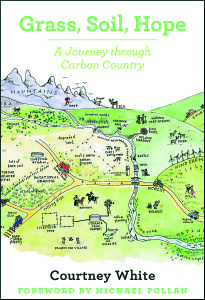 By Courtney White (Chelsea Green Publishing, May 2014, 272 pages, Paperback $19.95)
By Courtney White (Chelsea Green Publishing, May 2014, 272 pages, Paperback $19.95)
Book Review by Jennifer Highland
When was the last time you saw a book about climate change that featured the word “hope”? That alone is good reason to read this book and share it with everyone you know. Author Courtney White is so brimful of optimism on this usually fraught subject that you may occasionally want to tell him to calm down. Still, the core message in Grass, Soil, Hope is both exciting and empowering: the potential to stop climate change is already in our hands and under our feet.
The soil is the world’s largest available carbon sink—a place to redirect problematic carbon dioxide from the atmosphere, and it has a large unused capacity, White explains. Plants pull CO2 out of the atmosphere via photosynthesis, and farmers can use relatively low-tech methods to encourage plants in turn to pump it into the soil. Given that much of the world’s croplands, rangelands, and deserts are carbon-poor after centuries of mismanagement, this represents a huge opportunity.
This climate solution requires that we rethink modern agriculture. Practices like plowing, overgrazing, monocropping, and application of chemical fertilizers and pesticides have gravely depleted many soils of carbon, valuable nutrients, and microbial life. Reversing this trend requires using different techniques—some old, some new, but all well-proven to rebuild soil health while growing more healthful food for all of us. This win-win approach has been dubbed “regenerative agriculture.” And it gets even better.
Over the course of the book, White takes us on a virtual journey to farms, ranches, backyards, and meadows where real people have been pioneering real solutions. While many of the case studies are not so relevant to New England, he does profile a New Hampshire organic farmer, two backyard permaculturists from Holyoke, MA, and rooftop gardeners in New York. While Northeast pastureland is quite different from rangeland in the arid West or Australian Outback, some of the grazing practices developed in those settings may still enhance outcomes for Yankee farmers. And that is the beauty of practices that build soil carbon—they improve outcomes on many levels. Just as one poor choice can beget many bad effects, White reminds us over and over that one positive move brings with it a host of co-benefits. Regenerative agriculture provides a long list of positives, including increased soil productivity, improved food quality and nutrition, higher profits for farmers, increased soil water storage leading to increased system resilience, greater biodiversity, high quality wildlife habitat—and, oh yeah, saving the planet from climate catastrophe.
In short, Grass, Soil, Hope may change your thinking about atmospheric CO2, from serious problem to golden opportunity. White’s mission with this book appears to be to jump-start a carbon revolution that is already underway, taking it from the margins toward the mainstream. It is by no means a how-to manual, although he outlines many basic principles. Those who really want to dig in and start “carbon-farming” in their own fields, yards, and communities will want to follow up on some of the references and organizations sprinkled throughout this book and seek out more detailed resources. This book will give you a good sense of the territory and the possibilities, and will fire you up with the excitement of becoming part of the solution. The solution will need all of us, not just farmers. It will require new businesses, venture capital, political activism, canny food-shoppers, innovative policies, nonprofits, and more. There is a place for each of us at this table, once we start to see the world through the lens of carbon. In the end, that is the greatest source of hope.
Jennifer Highland is on the board of the Plymouth Area Renewable Energy Initiative. She practices osteopathy out of New Hampshire’s first solar-powered medical office.








Leave a Reply